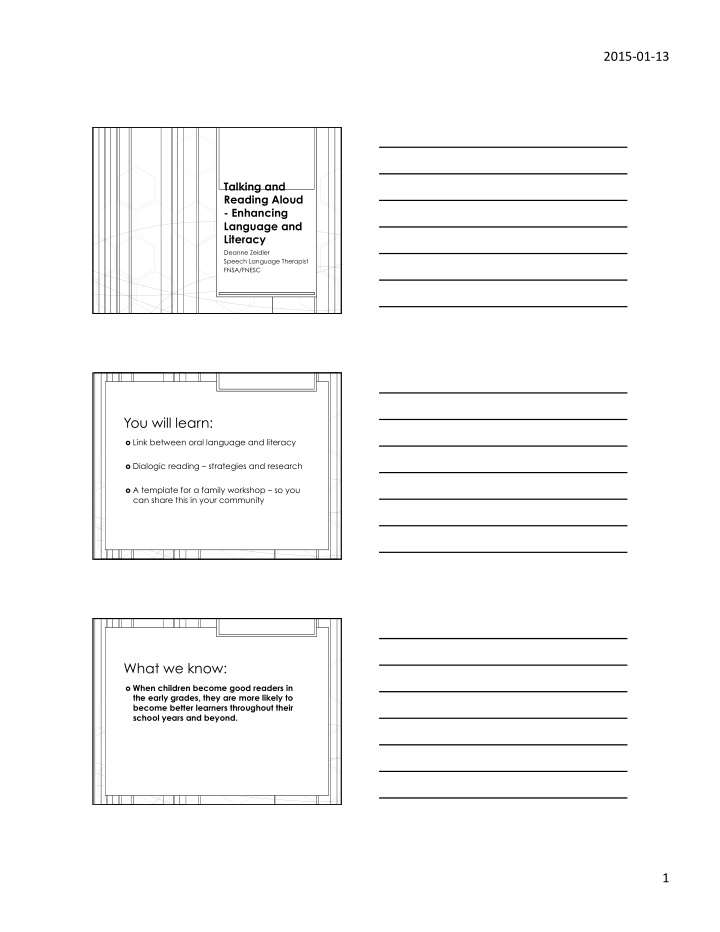



2015-‑01-‑13 ¡ Talking and Reading Aloud - Enhancing Language and Literacy Deanne Zeidler Speech Language Therapist FNSA/FNESC You will learn: Link between oral language and literacy Dialogic reading – strategies and research A template for a family workshop – so you can share this in your community What we know: When children become good readers in the early grades, they are more likely to become better learners throughout their school years and beyond. 1 ¡
2015-‑01-‑13 ¡ Speaking and Listening are the first steps to reading and writing. Becoming a reader . A child needs to… use language in conversation listen and respond to stories read aloud recognize and name the letters of the alphabet listen to the sounds of spoken language connect sounds to letters to figure out the “code” of reading read often so that recognizing words becomes easy and automatic learn and use new word s understand what is read Dialogic Reading. Dialogic Reading is shown to have positive effects on a foundational skill for literacy. Researched for over 15 years by Dr. Grover Whitehurst. We are going to learn more about how “talking about” books together with your child can provide a boost to their reading skills. 2 ¡
2015-‑01-‑13 ¡ Reading and Talking Aloud Welcome! Today we will learn ways to read books with children to develop their oral language skills. Please take a few minutes and choose a book that you think your child would like. Thinking back. Can you recall your favorite childhood story? What made listening to I The image cannot be remember stories books or books displayed. when….. Your computer may not special when you have enough memory were a child? to open the image, or the image may have Reading and Talking Aloud Promotes Oral Language Development Increases Vocabulary Increases Comprehension skills 3 ¡
2015-‑01-‑13 ¡ Creating a good fit… A sk L isten T hink E xpand R epeat A SK L isten and t hink about what your child says.. 4 ¡
2015-‑01-‑13 ¡ E xpand R epeat Do you notice how this dad ALTERs while he reads together with his son? 5 ¡
2015-‑01-‑13 ¡ 5 Tips for Reading and Talking Aloud Together To help our children learn to talk and read, we need to give them a turn. We can do this when we … 1. Open-ended questions 2. Talk about the details of the story 3. Think about connecting the book to your child’s experiences 4. Fill -in opportunities 5. Five easy questions Number O ne. O pen-Ended Questions Open-ended questions allow children to talk about what they know and give full and meaningful answers. Closed-ended questions require only a short or one word answer. Examples of open-ended questions. What’s happening? What do you think…? O pen Ended 6 ¡
2015-‑01-‑13 ¡ Your Turn… Open Ended Questions Look through your book. On a sticky note, think of and write down the open ended question that you will ask your child. 19 Number T wo. T alk about details Ask questions and discuss details of the book. You can do this while you are reading or after you have finished the book. What details about the pictures, characters or story do you want to help your child remember? T alk about Details 7 ¡
2015-‑01-‑13 ¡ Your Turn… Talk about the details On a sticky note, write a reminder to ask about a detail in the story. “What was your favorite part of this story?” “Do you remember _____________?” Number Th ree. Th ink making connections between the book and your child’s experiences. What is the book about? Have you ever seen a…? What pictures might your child recognize? Have you seen a…? What words might be new for your child? Do you know what ……means? Relate what is unfamiliar to events and ideas that your child knows and understands. Think about making connections 8 ¡
2015-‑01-‑13 ¡ Your Turn… Think about connecting the book to what Your child knows Look through your book and choose a picture/ word that is familiar to your child. On a sticky note, write a reminder that will help you relate a word/picture/idea to your child’s own experience. Number F our. F ill in Opportunities Children often love reading familiar books over and over again. Create opportunities for your child to participate in reading the book by allowing him/her to “fill in” sentences. F ill in 9 ¡
2015-‑01-‑13 ¡ Your Turn… Fill in Look through your book. On a sticky note, write a reminder to provide your child with an opportunity to “fill in” a word or phrase. Number F ive. F ive Wh Questions Use the 5 W’s Easy to Hard Questions What Where Who When Why 10 ¡
2015-‑01-‑13 ¡ Your Turn… Wh - Questions Look through your book. On a sticky note, write a wh-question that you will ask your child. With your child this week.. � Children love reading the same books over and over again. Read each book with your child several times. Use a few different kinds of questions to hold your child’s attention as you read each page. Encourage your child to give you more information and more detailed answers with each reading of the book. With your child this week.. � Ask your child to tell you the story. Most of all, remember to have FUN reading books together. 11 ¡
2015-‑01-‑13 ¡ What about e-books? There are many books available on ipads/ tablets with lots of engaging features. Remember! Recognize the novelty factor Enjoy the features, but don’t forget the story! Stay present with your child and the book experience! If you would like a copy of this family workshop, please email me: � Deanne Zeidler, Speech Language Therapist � � deannez@fnesc.ca � � � 1 604 785 0447 � 12 ¡
Recommend
More recommend